Part of a series of articles titled What Daddy and Mother did in the War.
Article
What Daddy and Mother did in the War (Part 2)
This is Part 2 of "What Daddy and Mother Did in the War," by their daughter, Stephanie Johnson Dixon. Read Part 1 first.
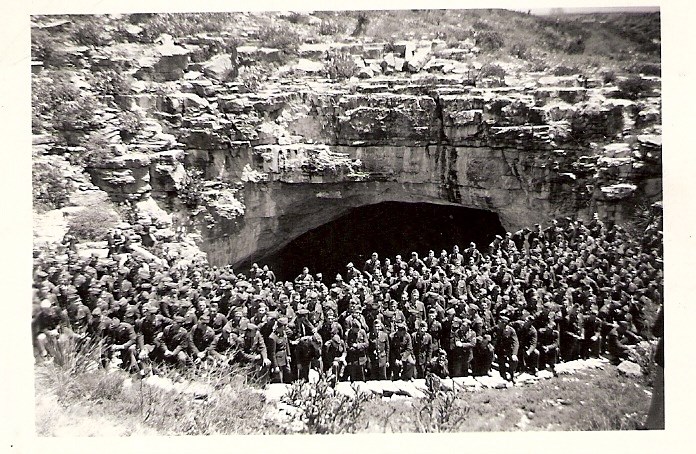
Bob Johnson, courtesy of his daughter Stephanie Dixon.
Boogie Woogie Bugle Boys: The 206th Coast Artillery National Guard Unit from Marianna
Bob Johnson learned to play the trombone in the 206th Coast Artillery (Anti-Aircraft) Band. It was a lucky break for him. This skill may have saved his life. T. A. Futrall High School in Marianna did not have a band when he attended. As a three-sport letterman (football, basketball, and track), he wouldn’t have joined the high school band if they had one. And yet, when there were openings in the 206th Medical Detachment and Band, he was recruited, joined, and either selected or was handed a trombone.
It is unlikely that the horn he wound up playing through the war was the same one originally issued. Family lore has it that his parents purchased a really good instrument for him at some point. Said trombone was a second-hand Olds model, a fine instrument with a small bell and a pure tone that was the envy of every high school trombonist that Bob’s daughter, Stephanie, ran into when she was playing that same trombone in high school.
Beadie Johnson stated on more than one occasion that a price of $400 was paid for the used horn which took her son through World War II. Not to doubt her word, but this seems excessive, especially since it was during the Depression and a whole house could be purchased at that time for $500. Bob’s surviving sister, Lois Barnett Duke, told that during the war she bought a “rat-trap house” for $500 at the conjunction of Highway 1 North and Highway 79 by the railroad overpass. (Duke)
Bill Dixon researched the history of the trombone in Stephanie’s possession, the one Bob Johnson said carried him through the war. The horn’s serial number indicates that it was made in December of l941. Since Bob stated that the trombone was bought used for him by his parents, it is not possible for that particular horn to have been in his possession until sometime up in the war. In all likelihood, he started out with a National Guard issued trombone when he joined the Guard. It seems a good bet that Beadie and Floyd might have purchased a better instrument for him and given it to him when he came home in ‘43 for his furlough. The Depression was over and times were better so they could probably afford it by then. And, of course, for all practical purposes, Bob was a professional musician and needed a better instrument.
Internet postings on that Olds trombone claim that this was, indeed, a valuable horn. The F.E. Olds company at that time made trombones that were known for their dark tones due to the heavy metals in them. As the horn was played louder, the tone brightened. The horn was prized then, as now, by blues musicians.
Not that the source of Bob’s trombone training matters. He may have been a great athlete, but his true talent was musical. Since he was a boy, he was chosen by Marianna’s long-time music teachers, Mr. Evans and Miss Helen Greenhaw, to perform as a soloist, in duets, quartets, and in larger groups. He was a tenor and performed throughout Lee County and adjoining counties whenever one of the music teachers got their students a gig. He often was invited to perform with older singers around Marianna in barbershop quartets and choirs. This went on for his entire life in church choirs and pick-up groups.
Clearly, he understood the rudiments, such as rhythm, harmony, and reading music. And he was a quick study. All of his children regularly heard him sing songs, working in all four parts by himself. Neither they nor any who heard him “get his lip back” in one or two practices for a Clown Band performance for community parades years after the war have any trouble believing that he would soon be an adept trombone player after the merest introduction to the instrument.
The Medical Detachment part of Bob’s assignment was harder to believe. Bob Johnson, despite the fact that he served in a war and in later life was a butcher, could barely stand the sight of blood. He was known to get sick and even faint when one of his children was injured. None of us ever questioned his bravery, and yet a couple of us witnessed family emergency medical events in which he was rendered partly or totally useless. This is not the best trait for one in a military medical detachment to possess.
However, the band and the medics were joined at the hip. Traditionally, the military medical corps is taken from the ranks of the band. It is their primary role during fighting. Bob did not talk much about this facet of his service. In fact, he scarcely mentioned it at all. Although he did talk about some of his duties after the Japanese bombed Dutch Harbor, Unalaska, and the action he spoke of clearly involved helping with casualties.
Dr. Bob Boon said that they had absolutely no medical training, and he should know. He said that although the band was designated as part of the Medical Detachment, their role was supposed to be auxiliary medical corps, or stretcher bearers. (Boon)
It should be mentioned that Bob Johnson also possibly joined the Marianna Unit of the National Guard due to its commander, Col. Elgan C. Robertson. He always spoke of Col. Robertson, eventually to become General Robertson, with respect and affection. And on their return home when General Robertson resumed his civilian job as a bank president, he treated Bob well.
Elgan C. Robertson was a World War I veteran and had taken part in the Mexican Expedition of l916-17 under General John Pershing prior to that. After the first World War, starting in l927, he commanded an artillery battery for the Guard, the 206th in Marianna. His civilian job was president of First National Bank in Marianna. He also held a large interest in a bank in Helena. In l941 he was the vice president of the Arkansas Bankers Association. He would have moved up to the presidency of that group, but for the lead up to war. (Goldstein, Donald and Dillon, Katherine)
Col. Robertson had a reputation of having a cohesive, well-disciplined Guard unit. The 206th was called for training at Fort Bliss in El Paso in January of l941. Everyone knew that the world was becoming a dangerous place with Germany and Japan becoming growing menaces, but none of the young men could have predicted on what twists of fate their lives would turn in the next few years.
“When Hitler pounced on Poland, we all knew that something was going to happen. President Roosevelt was interested in getting involved. It was time to get everybody ready,” Boon suggested. It wasn’t that big of a surprise by the time the 206th was activated and sent off to Ft. Bliss in El Paso, Texas for war training. So most of the young men from the 206th deferred going back for another semester of college until they had completed their Ft. Bliss assignment and the month or two needed to finish out their year-long commitment.
Bob and his mother, Beadie, related to Stephanie the send-off that Marianna gave to their boys in the 206th the day they marched off for their training in January of l941. Beadie was working at West Department Store in Marianna. The boys marched through Marianna in parade as they headed either to the train depot or to gather for a motorized convoy. Bob and Bobby Boon got to Texas via the train, while Roy Williams remembers riding down there in a truck and equipment convoy. (Boon, Williams) By either conveyance, it was a three-day journey. (Goldstein, Dillon)
All the stores closed temporarily for the send-off parade. As the Guard marched past Beadie’s post in front of West Department Store on Poplar Street, she saw her only son go past. She said she managed to hold it together until all the boys went by, then she and a co-worker, another woman with a son who was leaving, went to the back of the store and burst into tears. Beadie reported that the manager was very kind to them. He told the women that they could go to the stockroom for a while and then could go home for the day.
The Army National Guard 206th Coast Artillery was made up of Headquarters Battery, the Medical Detachment and Band from Marianna, the First Battalion, Battalions D and F from Russellville, Battalion B from Monticello, Battalion C from Jonesboro, Battalion G from Helena, H Battalion from Hot Springs, and Headquarters Second Battalion at El Dorado (Goldstein, Dillon). Many of the men in the 206th were college students. In fact, the entire Arkansas Tech football team from Russellville was activated.
This regiment included searchlight and radar batteries, anti-aircraft (the main mission), and an automatic weapons unit. In addition to these missions, which they carried out in Alaska, they carried and moved heavy equipment over frozen or muddy roads, built the roads, strung wire for vital communication, built outposts and foxholes, and in the case of one Ralph Beauchamp, ran water line all over the island. In civilian life Ralph was a master plumber. (Beauchamp)

Bob Johnson, courtesy of his daughter Stephanie Dixon
Don't Get Around Much Anymore: Fort Bliss
The 206th was federalized on January 6, l941 and sent to Fort Bliss in El Paso, Texas on January 14. (Goldstein and Dillon) They ceased to be under the direction of their state’s governor and adjutant general and went under the direction of federal forces and the president of the United States. They would serve in this manner for the duration of the war. The men were still laboring under the delusion that their enlistment would be up in a year. Their training would be completed at Fort Bliss and they would be deployed to the Aleutians in August of 1941, they thought at that time. During their encampment in Fort Bliss the band rehearsed. The new recruits from Monticello brought along their band director who had just graduated from Monticello. The gun batteries, trained on new equipment and old WWI equipment.
At El Paso, the boys who had known only Arkansas climate and terrain were exposed to desert conditions. It was windy; there were no windbreaks; there were sandstorms, extreme heat, with temperatures dropping significantly at night. During the winter months it could be positively chilly. Most of the men bunked in tents, but were able to use latrines with decent sanitary conditions. This would not be the case when they got to Alaska. (Boon)
Shortly after the Arkansas Unit began training, the 200th National Guard Regiment from New Mexico arrived. The unit arrived as a cavalry unit, complete with horses. After some war games, athletic contests, and competitive jibing back and forth, the Arkansas unit and the New Mexico unit developed a camaraderie. The New Mexico unit lost their cavalry status and were made an artillery unit shortly after their arrival, so part of the 206th mission was to train these troops in their outmoded artillery. These two regiments of young men from very difference states started their service together but went off to suffer through very different fates. (Johnson)
The 206th time at Ft. Bliss was notable for a couple of things. First, the horse cavalry unit stationed at Ft. Bliss was decommissioned. The band played for the ceremony of the last horse cavalry parade on American soil. (Boon) Of that ceremony, Dr. Boon said, “It was just about the most impressive thing I saw in my time in the military.” It should be mentioned that Dr. Boon’s father and grandfather were in the horse and mule business back in Lee County, and that Boon’s father was a well-known horseman. He fancied Tennessee Walkers in particular, and rode one regularly from his house to his place of business in town.
The second thing was of great import to all of the men in the 206th. It was the Coin Toss.
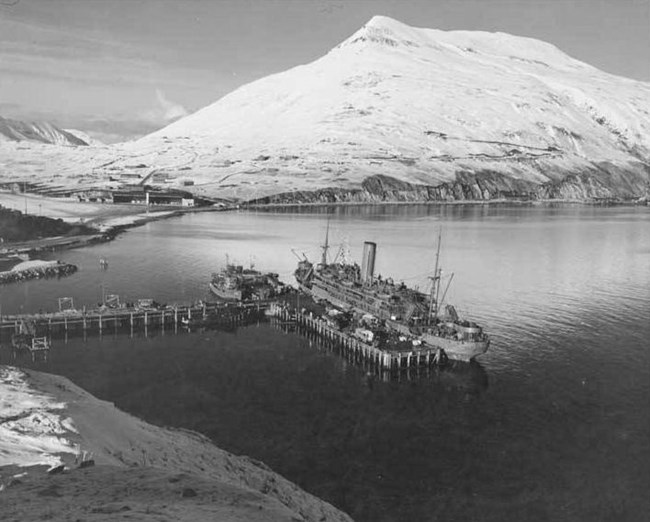
Bob Johnson, courtesy of his daughter Stephanie Dixon
Between the Devil and the Deep Blue Sea: The Coin Toss
In July 1941 word came down that the different guard units at Ft. Bliss would get their next duty assignments. A little later rumors went through the camp that the choices were to be either the Philippines or a place in Alaska that no one had ever heard of…Dutch Harbor. Both were considered overseas assignments. The soldiers of the 206th had a clear favorite. They wanted to be sent to the Philippines, mostly for the weather, but also because it was perceived to be the least dangerous of the two assignments. Alaska was uncomfortably close to Japan. (Boon, Goldstein and Dillon, Johnson)
The Aleutian Islands are an archipelago of 100 islands dotting the western part of Alaska’s peninsula. Dutch Harbor is on the largest of these islands, Unalaska. The winds come out of Siberia with ocean currents from the Bering Sea. But this unattractive vacation climate has other problems. The winds and currents meet the warm air and currents from the Pacific Ocean with a clash that stirs up extraordinarily high winds, rain, thick fog, and snow. (USN Combat Narratives)
These storms are called “Williwaws” by the locals and have to be experienced to be believed. In Dutch Harbor during the war the wind was so fierce it blew off an eight ton steel mat, a Marsdan Mat, that had been placed over a landing strip to allow planes to land in the winter. It simply rolled up. Military trucks got blown over. (Boon)
The soldiers of the 206th did not know yet of the infamous Williwaws when they first arrived, but they already knew that they didn’t want to go to Alaska. Alaska was the closest American land mass to Japan. It was widely believed at the time that when and if Japan did attack, it would be through that route. (Goldstein and Dillon)
July 28, 1941 the men of the 206th Coast Artillery got their orders. They would be headed for Dutch Harbor, Unalaska and the decision had been made by a coin toss! What happened was that the commander of the 206th Coast Artillery (Anti-Aircraft) from Arkansas, Col. Robertson, and the commander of the 200th CA (AA) from New Mexico got together and settled the matter with the toss of a coin. (Beauchamp, Boon, Bob Johnson)
Although this unlikely story has been disbelieved by many through the years, it was confirmed as the truth by Col Robertson himself. In the exquisitely researched and highly readable book, “The Williwaw War” by Goldstein and Dillon the writers claim that “at a reunion of the 206th in l960, Colonel Robertson confirmed that this unlikely event did in fact take place.” (Goldstein and Dillon, p. 354) Not many who knew the man would question Robertson’s veracity on this point.
The story further goes that the winner of the coin toss (heads) went to the Philippines. This much is known to be true and factual. The New Mexico unit, most of them from one town, deployed to the Philippines where they fought, were captured by the Japanese, and force-marched in the Bataan Death March. The men from New Mexico, whom the Arkansas unit had become so close to, were wiped out.
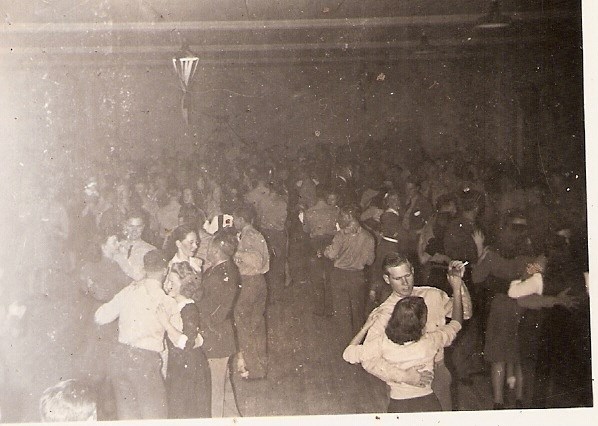
Bob Johnson, courtesy of his daughter Stephanie Dixon
Baby, It's Cold Outside: North to Alaska
On July 31, 1941 the men of the 206th Coast Artillery (AA) got their last paycheck in El Paso. They were due to start out for Dutch Harbor the next day. They would be at liberty that night and the base’s proximity to Juarez, Mexico was problematic. However, Col. Robertson declared that there would be no restrictions on liberty, meaning that the guys could go and do what they wanted to, as long as they were back bright and early and ready to go the next morning. Remarkably, every single one of them complied….every single officer, every single soldier, every last one of them. There were 1,700 soldiers plus officers in the regiment. (Goldstein and Dillon, p 24)
By official Army edict they left El Paso by train in wool winter garments. Well, the Army deduced that they were headed for Alaska. But it was summer in the Southwest and their first stop was Yuma, Arizona. The train was a 40-car troop train, carrying troops, artillery, and all of the other equipment that an army unit must have to function. (Goldstein and Dillon)
They traveled through Utah and into northern California, eventually stopping at Ft. Lewis, Washington near Tacoma. It took 4 or 5 days to reach Ft. Lewis. They were encamped there for a bit and many of the men fell in love with the beauty of the country. There was time for recreation, competitive games, trips into town, and dances, some of which the 206th Band played for. (Johnson, Williams)
Roy V. Williams, 83, also of Huntsville, Alabama started his war experience with Bob Johnson and Bobby Boon. Bob was a trombonist, Bobby a saxophonist, and Roy a trumpet player. They were all college boys, either just graduated or still in. Roy Williams had just collected his B. S. in Engineering from a college in Indiana. Bobby Boon was taking leave from Kemper Military School in Tennessee. Bob Johnson had attended college in south Arkansas.
Once at Ft. Lewis, Roy Williams stated, “A call went out for people who might want to be officers. They gave me an I.Q. test, and I must have passed it, because they shipped me out to North Carolina for Officer’s Candidate School. I didn’t see the guys again till the war was over. (Williams)
Dr. Boon was questioned by Stephanie on how it was that Roy Williams scored high enough on the test and Boon, a person of obvious high intelligence, didn’t. Boon reported that getting most of the men to volunteer for officer training was a pretty tall order. He said that he, himself, had decided against it after seeing some films featuring officers having to lead men into dangerous situations, so he declined the offer.
The 206th stayed at Ft. Lewis long enough to gather troops from other parts of the country, get some new equipment, including the first units of a new kind of technology, radar, and train on it. Dr. Boon reported that the regimental band, of which he and my father were a part, shipped out toward Alaska on October 10, 1941 aboard the USS Grant.
The Grant was a small World War I vintage ship commandeered from the Germans at the end of the First World War. It was a cruise liner, not that the soldiers would know that, and carried cruise passengers up and down the western coast between Washington and Alaska for many years. In a bit of historical irony, the Grant, originally named the Konig Wilhelm (under which it sailed from 1907 to 1917), during 1917-1919 was named the Madawaska. The ship was named for a town in Maine. Madawaska is a Mallescite Indian word meaning “land of the porcupine.“ (Department of Navy, Hartwell) So the troop ship that took them to the Aleutians at one time was named for the men’s old high school mascot, the Porcupines.
The ship was renamed the USS Grant in 1919 and sailed as that until 1941. During the sailing to the Aleutians, on the upper decks passengers and officers enjoyed comfort and amenities. However, the soldiers’ bunks were below deck, down in the cargo hold and below the water line, and infested with bed bugs. The 800 plus men aboard threw the mattresses overboard and slept either in the aisles or on deck. Seasickness was the order of the day. (Goldstein and Dillon, Bob Johnson).
Dr. Boon must not have suffered from seasickness since he claimed that it wasn’t too bad a trip. Bob Johnson had another story. He was miserable, as were many of the others.
The Grant took the Inside Passage with a few stops at ports such as Ketchikan and Skagway along the way. They went to Seward and did not disembark until they arrived at Dutch Harbor, ten days after they left the mainland. (Goldstein and Dillon) Williwaw season was not there yet. (Boon)
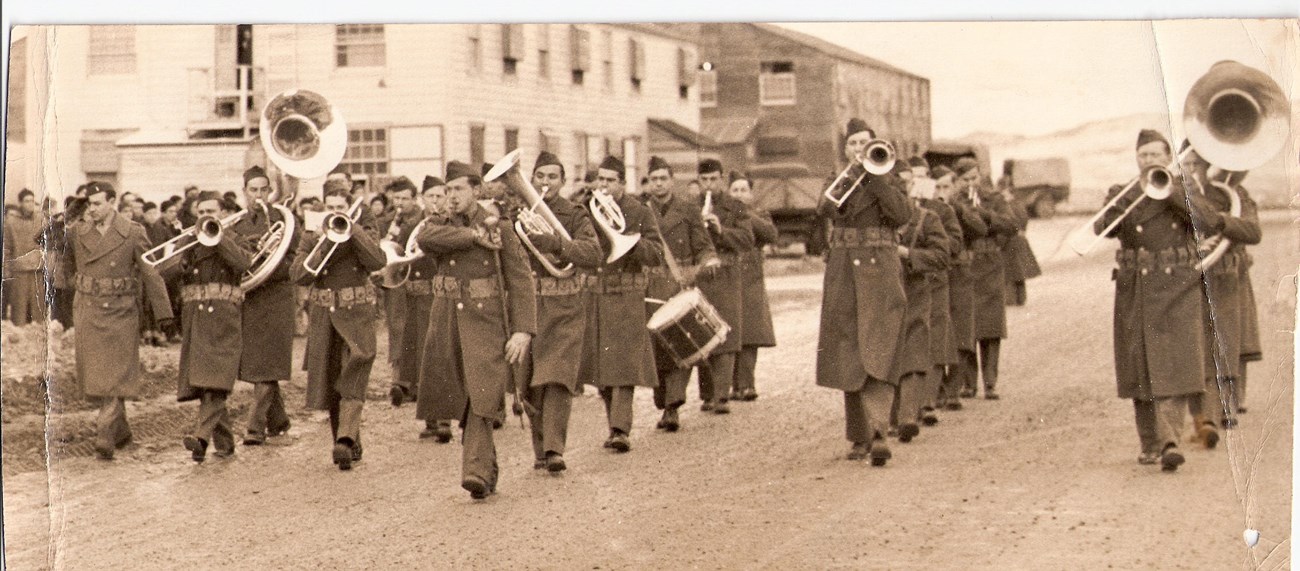
Bob Johnson, courtesy of his daughter Stephanie Dixon
Goldstein and Dillon, the authors of The Williwaw War wrote that the men of the 206th arrived in Alaska in mid-November of l941, a few weeks before Pearl Harbor. Dr. Boon stated that they may have been there six-to-eight weeks before the Japanese bombed Pearl Harbor. Dr. Boon’s memory generally is pretty accurate, while Goldstein and Dillon had access to official records, so there is a conflict about the accurate date of their arrival.
Be that as it may, one can only imagine how these inexperienced young Arkansas men reacted after being sent to west Texas for desert training and finally arriving at the extreme northern end of the world, and at the front end of the Alaskan winter. Nothing about it was reminiscent of home. The native Alaskans of the area, the Aleuts, called the marshy, spongy soil, “muskeg.” The servicemen had to sleep in Quonset huts that were partially underground to keep them from blowing away in the wind. It could be colder than a witch’s elbow. There were those cussed williwaws. And the weather was wholly unpredictable.
The most difficult part of their adjustment was dealing with the weather. At first they were housed in wooden huts, distinguished mostly by the other residents, rats. According to Dr. Boon, “We had to dig into the side of the hill. We’d build these Quonset huts in the holes and partly covered them up to keep the wind from knocking them over. The ones that weren’t buried up that way, they had to string wires over them and hold them down with stakes to keep them from blowing off the sheet metal. The wind was so high it could turn over military trucks.” But the Quonset Huts were amenities compared to their first shelter.
They then started in on doing what they had been sent to do. At Dutch Harbor and later at Amchitka, Boon said the band practiced, marched in some parades, went down to the docks and played when the troop ships came in, played hymns at the chapel and at funeral ceremonies when officers died. He suggested that what the band enjoyed the most was playing in the dance band that entertained at the Officer’s Club dances (with the female nurses in attendance), and at the NCO Club about once a week. “We got a little whiskey and maybe a little cash from the tip jar. Our headquarters was a hole in the ground, but the Officer’s Club was where the nurses were. Of course they were all officers and couldn’t date enlisted men.”
Both Bob and Dr. Boon seemed to have good memories of having been in the band. They enjoyed the camaraderie and the music. Several of the men had specialty musical numbers that they performed and which became popular requests. Dr. Boon sang cowboy songs and his singular number was “The Birmingham Jail.” A photo that he has from that time shows a small group of musicians dressed up as country and western performers.
Bob Johnson's specialty was the Bunny Berrigan hit “I Can‘t Get Started.” (Bob Johnson) The music was written by Vernon Duke with lyrics by Ira Gershwin.
Here are Gershwin’s lyrics:
I’ve been around the world in a plane
I’ve settled revolutions in Spain
The North Pole I have charted
Still I can’t get started with you.
And at the golf course I’m under par
Metro-Goldwyn has asked me to star
I’ve got a house a show place
Still I can’t get no place with you
You’re so supreme
Lyrics I write of you
Dream, day and night of you
Scheme, just for the sight of you
Oh Babe, what good does it do?
I’ve been consulted by Franklin D.
And Greta Garbo has asked me to tea
But I’m broken-hearted
Cause I can’t get started with you.
As one who remembers being serenaded to that tune, I can only report that my dad did a terrific Bunny Berigan impression. I do not know if he played the tune’s signature trumpet solo on the trombone or if a trumpet player from the band stepped in to share the spotlight, but the vocalist was tops. It is easy to understand that a soft tenor singing a medium tempo, popular swing tune about unrequited love way up would bring them to their feet begging for more way up in the Aleutians. Plus, I can say, without fear of contradiction, that “I Can’t Get Started” was the last song that was sung to Daddy in his lifetime.
I always assumed, because our Mother told me so, that Dad’s Army nickname of “Bunny” came from his impression of Bunny Berigan. Dr. Boon disagrees. “I think it came from his sports days, and we played sports in the Aleutians as well as in high school. Everyone thought he was small, but fast.”
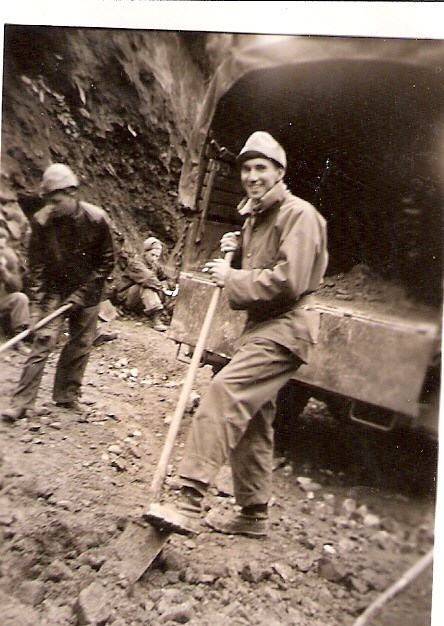
Bob Johnson, courtesy of Stephanie Dixon
Away from their band duties they helped out the camp in other ways. “Because there were not enough personnel, some of the guys helped on Navy PBY’s (Patrol Bomber, a seaplane) and others, served as ammunition passers and on gun crews.” Boon worked at the base hospital as a lab assistant. Horace Bonner was a trained accountant and did that.
The band was given a chance to help out other places, played in the NCO club maybe once a week and at the Officers' Club. They also got proficient with shovels. The gun batteries were in the process of digging in, the Corps of Engineers were not there yet, so the job had to be done by shovel and wheel barrow. No earth moving equipment was on the islands yet.
Boon continued, “We spent most of the time digging holes and preparing huts. I think we adjusted well. There was lots of horseplay and we were a very compatible group, most of whom had been in college. We had little dissension, and didn’t pull KP. For our physical regimen we did calisthenics each morning.”
This is Part 2 of "What Daddy and Mother did in the War." Read Part 3 next.
Last updated: July 18, 2025
